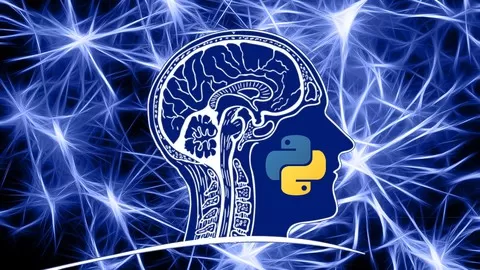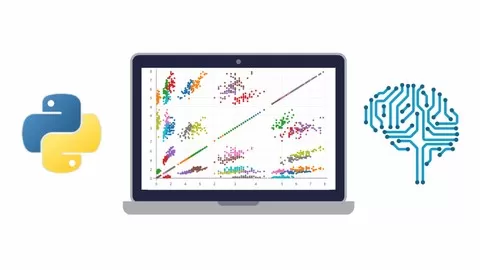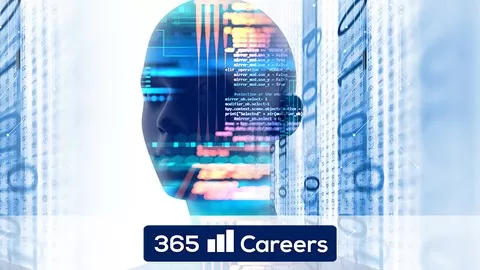A warm welcome to the Data Science with Python course by Uplatz.
Data Science with Python involves not only using Python language to clean, analyze and visualize data, but also applying Python programming skills to predict and identify trends useful for decision-making.
Why Python for Data Science?
Since data revolution has made data as the new oil for organizations, today’s decisions are driven by multidisciplinary approach of using data, mathematical models, statistics, graphs, databases for various business needs such as forecasting weather, customer segmentation, studying protein structures in biology, designing a marketing campaign, opening a new store, and the like. The modern data-powered technology systems are driven by identifying, integrating, storing and analyzing data for useful business decisions. Scientific logic backed with data provides solid understanding of the business and its analysis. Hence there is a need for a programming language that can cater to all these diverse needs of data science, machine learning, data analysis & visualization, and that can be applied to practical scenarios with efficiency. Python is a programming language that perfectly fits the bill here and shines bright as one such language due to its immense power, rich libraries and built in features that make it easy to tackle the various facets of Data Science.
This Data Science with Python course by Uplatz will take your journey from the fundamentals of Python to exploring simple and complex datasets and finally to predictive analysis & models development. In this Data Science using Python course, you will learn how to prepare data for analysis, perform complex statistical analyses, create meaningful data visualizations, predict future trends from data, develop machine learning & deep learning models, and more.
The Python programming part of the course will gradually take you from scratch to advanced programming in Python. You’ll be able to write your own Python scripts and perform basic hands-on data analysis. If you aspire to become a data scientist and want to expand your horizons, then this is the perfect course for you. The primary goal of this course is to provide you a comprehensive learning framework to use Python for data science.
In the Data Science with Python training you will gain new insights into your data and will learn to apply data science methods and techniques, along with acquiring analytics skills. With understanding of the basic python taught in the initial part of this course, you will move on to understand the data science concepts, and eventually will gain skills to apply statistical, machine learning, information visualization, text analysis, and social network analysis techniques through popular Python toolkits such as pandas, NumPy, matplotlib, scikit-learn, and so on.
The Data Science with Python training will help you learn and appreciate the fact that how this versatile language (Python) allows you to perform rich operations starting from import, cleansing, manipulation of data, to form a data lake or structured data sets, to finally visualize data – thus combining all integral skills for any aspiring data scientist, analyst, consultant, or researcher. In this Data Science using Python training, you will also work with real-world datasets and learn the statistical & machine learning techniques you need to train the decision trees and/or use natural language processing (NLP). Simply grow your Python skills, understand the concepts of data science, and begin your journey to becoming a top data scientist.
Data Science with Python Programming – Course Syllabus
1. Introduction to Data Science
•Introduction to Data Science
•Python in Data Science
•Why is Data Science so Important?
•Application of Data Science
•What will you learn in this course?
2. Introduction to Python Programming
•What is Python Programming?
•History of Python Programming
•Features of Python Programming
•Application of Python Programming
•Setup of Python Programming
•Getting started with the first Python program
3. Variables and Data Types
•What is a variable?
•Declaration of variable
•Variable assignment
•Data types in Python
•Checking Data type
•Data types Conversion
•Python programs for Variables and Data types
4. Python Identifiers, Keywords, Reading Input, Output Formatting
•What is an Identifier?
•Keywords
•Reading Input
•Taking multiple inputs from user
•Output Formatting
•Python end parameter
5. Operators in Python
•Operators and types of operators
– Arithmetic Operators
– Relational Operators
– Assignment Operators
– Logical Operators
– Membership Operators
– Identity Operators
– Bitwise Operators
•Python programs for all types of operators
6. Decision Making
•Introduction to Decision making
•Types of decision making statements
•Introduction, syntax, flowchart and programs for
– if statement
– if…else statement
– nested if
•elif statement
7. Loops
•Introduction to Loops
•Types of loops
– for loop
– while loop
– nested loop
•Loop Control Statements
•Break, continue and pass statement
•Python programs for all types of loops
8. Lists
•Python Lists
•Accessing Values in Lists
•Updating Lists
•Deleting List Elements
•Basic List Operations
•Built-in List Functions and Methods for list
9. Tuples and Dictionary
•Python Tuple
•Accessing, Deleting Tuple Elements
•Basic Tuples Operations
•Built-in Tuple Functions & methods
•Difference between List and Tuple
•Python Dictionary
•Accessing, Updating, Deleting Dictionary Elements
•Built-in Functions and Methods for Dictionary
10. Functions and Modules
•What is a Function?
•Defining a Function and Calling a Function
•Ways to write a function
•Types of functions
•Anonymous Functions
•Recursive function
•What is a module?
•Creating a module
•import Statement
•Locating modules
11. Working with Files
•Opening and Closing Files
•The open Function
•The file Object Attributes
•The close() Method
•Reading and Writing Files
•More Operations on Files
12. Regular Expression
•What is a Regular Expression?
•Metacharacters
•match() function
•search() function
•re match() vs re search()
•findall() function
•split() function
•sub() function
13. Introduction to Python Data Science Libraries
•Data Science Libraries
•Libraries for Data Processing and Modeling
– Pandas
– Numpy
– SciPy
– Scikit-learn
•Libraries for Data Visualization
– Matplotlib
– Seaborn
– Plotly
14. Components of Python Ecosystem
•Components of Python Ecosystem
•Using Pre-packaged Python Distribution: Anaconda
•Jupyter Notebook
15. Analysing Data using Numpy and Pandas
•Analysing Data using Numpy & Pandas
•What is numpy? Why use numpy?
•Installation of numpy
•Examples of numpy
•What is ‘pandas’?
•Key features of pandas
•Python Pandas – Environment Setup
•Pandas – Data Structure with example
•Data Analysis using Pandas
16. Data Visualisation with Matplotlib
•Data Visualisation with Matplotlib
– What is Data Visualisation?
– Introduction to Matplotlib
– Installation of Matplotlib
•Types of data visualization charts/plots
– Line chart, Scatter plot
– Bar chart, Histogram
– Area Plot, Pie chart
– Boxplot, Contour plot
17. Three-Dimensional Plotting with Matplotlib
•Three-Dimensional Plotting with Matplotlib
– 3D Line Plot
– 3D Scatter Plot
– 3D Contour Plot
– 3D Surface Plot
18. Data Visualisation with Seaborn
•Introduction to seaborn
•Seaborn Functionalities
•Installing seaborn
•Different categories of plot in Seaborn
•Exploring Seaborn Plots
19. Introduction to Statistical Analysis
•What is Statistical Analysis?
•Introduction to Math and Statistics for Data Science
•Terminologies in Statistics – Statistics for Data Science
•Categories in Statistics
•Correlation
•Mean, Median, and Mode
•Quartile
20. Data Science Methodology (Part-1)
Module 1: From Problem to Approach
•Business Understanding
•Analytic Approach
Module 2: From Requirements to Collection
•Data Requirements
•Data Collection
Module 3: From Understanding to Preparation
•Data Understanding
•Data Preparation
21. Data Science Methodology (Part-2)
Module 4: From Modeling to Evaluation
•Modeling
•Evaluation
Module 5: From Deployment to Feedback
•Deployment
•Feedback
Summary
22. Introduction to Machine Learning and its Types
•What is a Machine Learning?
•Need for Machine Learning
•Application of Machine Learning
•Types of Machine Learning
– Supervised learning
– Unsupervised learning
– Reinforcement learning
23. Regression Analysis
•Regression Analysis
•Linear Regression
•Implementing Linear Regression
•Multiple Linear Regression
•Implementing Multiple Linear Regression
•Polynomial Regression
•Implementing Polynomial Regression
24. Classification
•What is Classification?
•Classification algorithms
•Logistic Regression
•Implementing Logistic Regression
•Decision Tree
•Implementing Decision Tree
•Support Vector Machine (SVM)
•Implementing SVM
25. Clustering
•What is Clustering?
•Clustering Algorithms
•K-Means Clustering
•How does K-Means Clustering work?
•Implementing K-Means Clustering
•Hierarchical Clustering
•Agglomerative Hierarchical clustering
•How does Agglomerative Hierarchical clustering Work?
•Divisive Hierarchical Clustering
•Implementation of Agglomerative Hierarchical Clustering
26. Association Rule Learning
•Association Rule Learning
•Apriori algorithm
•Working of Apriori algorithm
•Implementation of Apriori algorithm











